Culture: Difference between revisions
imported>Teltura No edit summary |
No edit summary |
||
| (15 intermediate revisions by 3 users not shown) | |||
| Line 1: | Line 1: | ||
= | {{Culture | ||
== | |Name=The One Ring | ||
{{ | |PostShadowsName= | ||
|SortOrder=0 | |||
|Filename=Culture_The_One_Ring.svg | |||
|Side=None | |||
|Creator=Decipher | |||
}} | |||
{{Culture | |||
|Name=Dunland | |||
|PostShadowsName= | |||
|SortOrder=1 | |||
|Filename=Culture_Dunland.svg | |||
|Side=Shadow | |||
|Creator=Decipher | |||
}} | |||
{{Culture | |||
|Name=Dwarven | |||
|PostShadowsName= | |||
|SortOrder=2 | |||
|Filename=Culture_Dwarven.svg | |||
|Side=Free Peoples | |||
|Creator=Decipher | |||
}} | |||
{{Culture | |||
|Name=Elven | |||
|PostShadowsName= | |||
|SortOrder=3 | |||
|Filename=Culture_Elven.svg | |||
|Side=Free Peoples | |||
|Creator=Decipher | |||
}} | |||
{{Culture | |||
|Name=Gandalf | |||
|PostShadowsName= | |||
|SortOrder=4 | |||
|Filename=Culture_Gandalf.svg | |||
|Side=Free Peoples | |||
|Creator=Decipher | |||
}} | |||
{{Culture | |||
|Name=Gollum | |||
|PostShadowsName= | |||
|SortOrder=5 | |||
|Filename=Culture_Gollum.svg | |||
|Side=Both | |||
|Creator=Decipher | |||
}} | |||
{{Culture | |||
|Name=Gondor | |||
|PostShadowsName= | |||
|SortOrder=6 | |||
|Filename=Culture_Gondor.svg | |||
|Side=Free Peoples | |||
|Creator=Decipher | |||
}} | |||
{{Culture | |||
|Name=Isengard | |||
|PostShadowsName= | |||
|SortOrder=7 | |||
|Filename=Culture_Isengard.svg | |||
|Side=Shadow | |||
|Creator=Decipher | |||
}} | |||
{{Culture | |||
|Name=Moria | |||
|PostShadowsName= | |||
|SortOrder=8 | |||
|Filename=Culture_Moria.svg | |||
|Side=Shadow | |||
|Creator=Decipher | |||
}} | |||
{{Culture | |||
|Name=Raider | |||
|PostShadowsName=Wraith | |||
|SortOrder=9 | |||
|Filename=Culture_Raider.svg | |||
|Side=Shadow | |||
|Creator=Decipher | |||
}} | |||
{{Culture | |||
|Name=Ringwraith | |||
|PostShadowsName=Wraith | |||
|SortOrder=10 | |||
|Filename=Culture_Ringwraith.svg | |||
|Side=Shadow | |||
|Creator=Decipher | |||
}} | |||
{{Culture | |||
|Name=Rohan | |||
|PostShadowsName= | |||
|SortOrder=11 | |||
|Filename=Culture_Rohan.svg | |||
|Side=Free Peoples | |||
|Creator=Decipher | |||
}} | |||
{{Culture | |||
|Name=Sauron | |||
|PostShadowsName= | |||
|SortOrder=12 | |||
|Filename=Culture_Sauron.svg | |||
|Side=Shadow | |||
|Creator=Decipher | |||
}} | |||
{{Culture | |||
|Name=Shire | |||
|PostShadowsName= | |||
|SortOrder=13 | |||
|Filename=Culture_Shire.svg | |||
|Side=Free Peoples | |||
|Creator=Decipher | |||
}} | |||
{{Culture | |||
|Name=Site | |||
|PostShadowsName= | |||
|SortOrder=14 | |||
|Filename=Culture_Site.svg | |||
|Side=None | |||
|Creator=Decipher | |||
}} | |||
{{Culture | |||
|Name=Men | |||
|PostShadowsName= | |||
|SortOrder=15 | |||
|Filename=Culture_Men.svg | |||
|Side=Shadow | |||
|Creator=Decipher | |||
}} | |||
{{Culture | |||
|Name=Orc | |||
|PostShadowsName= | |||
|SortOrder=16 | |||
|Filename=Culture_Orc.svg | |||
|Side=Shadow | |||
|Creator=Decipher | |||
}} | |||
{{Culture | |||
|Name=Uruk-hai | |||
|PostShadowsName= | |||
|SortOrder=17 | |||
|Filename=Culture_Uruk-hai.svg | |||
|Side=Free Peoples | |||
|Creator=Decipher | |||
}} | |||
{{Culture | |||
|Name=Esgaroth | |||
|PostShadowsName= | |||
|SortOrder=18 | |||
|Filename= | |||
|Side=Free Peoples | |||
|Creator=-Enola- | |||
}} | |||
{{Culture | |||
|Name=Gundabad | |||
|PostShadowsName= | |||
|SortOrder=19 | |||
|Filename= | |||
|Side=Shadow | |||
|Creator=-Enola- | |||
}} | |||
{{Culture | |||
|Name=Mirkwood | |||
|PostShadowsName= | |||
|SortOrder=20 | |||
|Filename= | |||
|Side=Shadow | |||
|Creator=-Enola- | |||
}} | |||
{{Culture | |||
|Name=Spider | |||
|PostShadowsName= | |||
|SortOrder=21 | |||
|Filename= | |||
|Side=Shadow | |||
|Creator=-Enola- | |||
}} | |||
{{Culture | |||
|Name=Troll | |||
|PostShadowsName= | |||
|SortOrder=22 | |||
|Filename= | |||
|Side=Shadow | |||
|Creator=-Enola- | |||
}} | |||
'''Cultures''' are a core component of [[ | '''Cultures''' are a core component of [[The Lord of the Rings TCG]]. Excluding [[site]]s and [[The One Ring]], every card in the game belongs to one of sixteen distinct cultures. A culture's function is to easily distinguish cards that are likely to be related to one another (usually by a thematic element, such as [[race]] or locale). There are plenty of cross-culture strategies to be had, but for the most part cards of one culture play best with other cards of that culture. Each culture naturally has its own strengths and vulnerabilities; for instance, the {{C|Elven}} culture excels during the [[Archery Phase]], but the {{C|Shire}} culture—having no access to bows or bowmen—struggles in that phase but makes up for this in other areas. | ||
==Cultures==<!--This could use a one-sentence long bit on what each culture is good at in this game, I'm just not going to get around to it atm.--> | |||
{{Culture Table}} | |||
Except for {{C|Gollum}} culture, all cultures are exclusively Free Peoples or Shadow cards. As such, {{C|Gollum}} culture gets its own section, below. | |||
When the game's first set, [[ | When the game's first set, [[The Fellowship of the Ring]] released in 2001, it brought with it the first nine cultures: {{C|Dwarven}}, {{C|Elven}}, {{C|Gandalf}}, {{C|Gondor}}, {{C|Isengard}}, {{C|Moria}}, {{C|Ringwraith}}, {{C|Sauron}}, and {{C|Shire}}. The second base set (and fourth set overall) [[The Two Towers]] added three more: {{C|Dunland}}, {{C|Raider}}, and {{C|Rohan}} cultures. With the fourth base set and eleventh set overall, [[Shadows]], Decipher consolidated the various Shadow cultures. They retired most of the existing ones, and created three new ones divided along different lines: {{C|Men}}, {{C|Orc}}, and {{C|Uruk-hai}}. | ||
===Free Peoples=== | |||
Except for {{C|Rohan}} and {{C|Gollum}}, all of the Free Peoples cultures were introduced in [[The Fellowship of the Ring]], the first set. Rohan and Gollum were instead introduced a few sets later, in [[Towers Block]]. While new cards were added to each faction over time—{{C|Gandalf}} and {{C|Shire}} cultures in particular went from having relatively few [[companion]]s to many varied ones—no new Free Peoples cultures were added Gollum. | |||
* {{C|Dwarven}} culture consists of [[dwarf]]s, who had a large role in ''The Hobbit'' but a relatively small one in ''The Lord of the Rings''. Their main character is [[Gimli]], although many other [[unique]] characters with a relatively small role in ''The Lord of the Rings''—particularly {{Card|Durin III, Dwarven Lord}}—feature in dwarf decks. | |||
* {{C|Elven}} culture consists of [[Elf|elves]], chiefly the elves of Rivendell and Lothlórien but also one far-ranging elf archer from Mirkwood. Many elves, especially in earlier sets, are [[Ally|allies]], representing their tendency to not leave their home forests. The main characters of this faction are [[Legolas]], [[Arwen]], [[Elrond]], and [[Galadriel]]. | |||
* {{C|Gandalf}} culture chiefly consists of [[Gandalf]] and his various schemes and accoutrements. It started off with Gandalf as the only [[companion]] in the faction, but over time it added his friends like {{Card|Radagast, The Brown}}. It also became home to a number of subfactions or characters that don't fit into any other faction. The [[Ent]]s of Fangorn, chiefly [[Treebeard]], fit in here, as do the men of far-flung kingdoms (particularly Dale) that sent dignitaries to Elrond's council. It also includes oddballs like {{Card|Ghan-buri-Ghan, Chieftain of the Woses}} and {{Card|Grimbeorn, Beorning Chieftain}}. | |||
* {{C|Gondor}} culture consists of the [[Man|men]] of Minas Tirith, their allies in Dol Amroth, and the rangers of the Dúnedain. It also includes their Númenorean ancestors, like {{Card|Elendil, the Tall}} and {{Card|Isildur, Bearer of Heirlooms}}, and the [[wraith]]s bound by those ancestors, like {{Card|King of the Dead, Oathbreaker}}. The main characters of this faction are [[Aragorn]], [[Boromir]], and [[Faramir]]. | |||
* {{C|Rohan}} culture consists of the men of Rohan, both the fighting horselords and -lady and the armies of the Riddermark, but also the [[villager]] civilians (appearing as [[Ally|allies]] and [[follower]]s) they are protecting from Saruman's encroachment. The main characters of this faction are [[Eomer]], [[Eowyn]], and [[Theoden]]. | |||
* {{C|Shire}} culture consists of the [[hobbit]]s of the Shire, and until [[Reflections]] there was at least one {{C|Shire}} card in every single game. Hobbits tend to be homebodies rather than going on foolish adventures, so many of them are [[Ally|allies]] instead of companions in early sets, and many more characters only appear as allies or [[follower]]s. The main characters of this faction are [[Frodo]], [[Sam]], [[Merry]], [[Pippin]], and [[Bilbo]]. | |||
=== | ===Pre-Shadows Shadow cultures=== | ||
Shadow cultures came in three waves: the initial cultures in [[The Fellowship of the Ring|the first set]], then two new cultures (plus {{C|Gollum}}, below) in [[Towers Block]], then a fundamental reorganization in [[Shadows]]. | |||
Fellowship Shadow cultures: | |||
* {{C|Isengard}} culture consists of the servants of [[Saruman]], as he unsuccessfully plots to play both sides against each other. It initially consisted of the fighting [[Uruk-hai]], but later includes [[Saruman]] himself, [[Isenorcs|his orc workers and overseers at Isengard]], his scouting force of [[warg-rider]] orcs, and [[Isengard Men|the disloyal men]] of Rohan led by [[Grima]]. | |||
* {{C|Moria}} culture includes the teeming [[Orc|goblin]]s that infest the former dwarven underground city of Khazad-dûm. As Boromir points out, they have the {{Card|Cave Troll of Moria, Scourge of the Black Pit}}. It also includes the huge monsters that dwell there, such as the [[Balrog]] and [[Creature|the Watcher in the Water]]. This is one of the smaller cultures, since all of the characters in it appear in the Moria portion of ''Fellowship of the Ring''. | |||
* {{C|Ringwraith}} culture is chiefly the nine unique [[Nazgul]], led by [[The Witch-King]] as well as a suspicious man from Bree, {{Card|Bill Ferny, Swarthy Sneering Fellow}}. Later it also includes [[Morgul Orcs|the orc armies of Minas Morgul]] that invade Osgiliath and a handful of miscellaneous [[wraith]]s not directly affiliated with the Nazgûl themselves. {{C|Ringwraith}} culture would later be renamed {{C|Wraith}} culture. | |||
* {{C|Sauron}} culture mainly consists of the [[orc]] and [[troll]] armies swarming out of Mordor to conquer Middle-Earth, led by [[Maia|Sauron]] himself. It's a large and varied faction overall. It's also a bit of a catchall, including some [[wraith]]s and {{Card|The Mouth of Sauron, Lieutenant of Barad-dur}}. | |||
Towers Shadow cultures: | |||
* {{C|Dunland}} is another small culture. It consists of the Dunlending [[Man|men]], ill-equipped barbarian raiders and long-time enemies of Rohan. Except for {{Card|Freca, Hungry Savage}}, all of the cards from this faction appear in [[Towers Block]]. | |||
{{ | * {{C|Raider}} culture is another culture of [[Man|men]], this time the ones in service to Sauron. It's siloed into three separate [[subculture]]s. The first two were introduced in Towers Block: the heavily-armed and disciplined [[Easterling]]s and the oliphaunt-riding archer [[Southron]]s. Later, [[Siege of Gondor]] in [[King Block]] introduced the larcenous sea-going [[Corsair]] pirates, led by an infamous Peter Jackson cameo card: {{Card|Castamir of Umbar}}. | ||
{{ | ===Gollum, playing both sides=== | ||
The {{C|Gollum}} culture is unique in being the only cross-alignment culture, having both [[Free Peoples]] and [[Shadow Alignment|Shadow]] cards. Free Peoples cards from this culture represent [[Smeagol|Sméagol]] as he serves Frodo and Sam as a simpering guide and scout, while the Shadow culture cards represent treacherous [[Gollum]], as he schemes to betray them to [[Shelob]] and steal the One Ring for himself. Those three characters are the only ones in this culture. (While Sméagol and Gollum are the same person in ''The Lord of the Rings'', they are considered separate characters for the purpose of this game, representing Gollum's tendency to act at cross-purposes with himself.) | |||
This was the only culture to make its first appearance outside of a base set, due to timing with the release of the movie ''The Two Towers''. As part of [[Decipher]]'s licensing agreement, they were not permitted to reveal any "spoilers", and so Decipher needed to wait for the [[Battle of Helm's Deep]] expansion four months later to explore [[Gollum]]'s split personality. It would be the last new culture of the [[Movie Block]] years. | |||
===Post-Shadows Shadow cultures=== | |||
With the release of the eleventh set, [[Shadows]], Decipher consolidated the various Shadow cultures, mostly retiring all of them except for {{C|Ringwraith}} (renamed {{C|Wraith}}) and {{C|Gollum}} cultures. This reorganization was largely along [[Race|racial]] lines rather than factional ones. hese new cultures could draw, from their first appearance, upon images and material from all three films, and were structured to avoid the limited scope that plagued some of the niche older cultures that only appeared in a few scenes. | |||
* {{C|Men}} (often called "Evil Men" or "Skull Men") contains all of the [[Man|men]] of {{C|Dunland}} and {{C|Raider}} cultures, the disloyal men of Rohan from {{C|Isengard}}, and suspicious men from Bree (previously only appearing as one {{C|Wraith}} card). | |||
* {{C|Orc}} culture contains all the orcs of {{C|Moria}} and {{C|Sauron}}'s armies, as well as the orc workers at {{C|Isengard}} and the [[Morgul Orcs]] from {{C|Ringwraith}}. | |||
* {{C|Uruk-hai}} culture contains all of the [[uruk-hai]] of {{C|Isengard}}'s army, as well as the Cirith Ungol uruk-hai garrison from {{C|Sauron}} culture. | |||
{{C|Dunland}} and {{C|Raider}} cultures were entirely retired. {{C|Isengard}}, {{C|Moria}}, and {{C|Sauron}} cultures occasionally appeared in post-Shadows sets, but only on unique characters that didn't fit neatly into the new cultures, like [[Maia|Sauron]], the [[Balrog]], and [[Saruman]]. These cards mostly weren't decks unto themselves, but rather meant to be [[splash]]ed into a deck that was primarily a different culture. | |||
This cultural reorganization was controversial with established players. While the new cultures incorporated the characters and names from the previous cultures, cards from the old and new cultures were still considered separate. For example, if you already had a {{C|Sauron}} [[besieger]] deck, the new {{Card|Beastly Olog-hai}} wouldn't work well in it, even though the Olog-Hai is part of the besieging armies of Sauron. If you wanted to use Beastly Olog-hai, you'd need to build a new deck, one using mostly new {{C|Orc}} cards. {{C|Wraith}} decks and {{C|Gollum}} decks avoided this pitfall, but other Shadow cultures were sharply split into pre-Shadows and post-Shadows cards that largely did not work well with each other due to incompatible [[cultural enforcement]]. | |||
Following the [[Shadows]] reorganization, no further cultures were added to the game. | |||
==See Also== | |||
* [[subculture]] | |||
---- | |||
{{Card Layout Table}} | |||
Latest revision as of 05:46, 26 September 2022
Cultures are a core component of The Lord of the Rings TCG. Excluding sites and The One Ring, every card in the game belongs to one of sixteen distinct cultures. A culture's function is to easily distinguish cards that are likely to be related to one another (usually by a thematic element, such as race or locale). There are plenty of cross-culture strategies to be had, but for the most part cards of one culture play best with other cards of that culture. Each culture naturally has its own strengths and vulnerabilities; for instance, the Elven culture excels during the Archery Phase, but the
Shire culture—having no access to bows or bowmen—struggles in that phase but makes up for this in other areas.
Cultures[edit]
| Cultures | |||||||
|---|---|---|---|---|---|---|---|
| Free Peoples | |||||||
| Movie-era Shadow | |||||||
| Shadows-era Shadow | |||||||
Except for Gollum culture, all cultures are exclusively Free Peoples or Shadow cards. As such,
Gollum culture gets its own section, below.
When the game's first set, The Fellowship of the Ring released in 2001, it brought with it the first nine cultures: Dwarven,
Elven,
Gandalf,
Gondor,
Isengard,
Moria,
Ringwraith,
Sauron, and
Shire. The second base set (and fourth set overall) The Two Towers added three more:
Dunland,
Raider, and
Rohan cultures. With the fourth base set and eleventh set overall, Shadows, Decipher consolidated the various Shadow cultures. They retired most of the existing ones, and created three new ones divided along different lines:
Men,
Orc, and
Uruk-hai.
Free Peoples[edit]
Except for Rohan and
Gollum, all of the Free Peoples cultures were introduced in The Fellowship of the Ring, the first set. Rohan and Gollum were instead introduced a few sets later, in Towers Block. While new cards were added to each faction over time—
Gandalf and
Shire cultures in particular went from having relatively few companions to many varied ones—no new Free Peoples cultures were added Gollum.
Dwarven culture consists of dwarfs, who had a large role in The Hobbit but a relatively small one in The Lord of the Rings. Their main character is Gimli, although many other unique characters with a relatively small role in The Lord of the Rings—particularly Durin III, Dwarven Lord (9R+3)
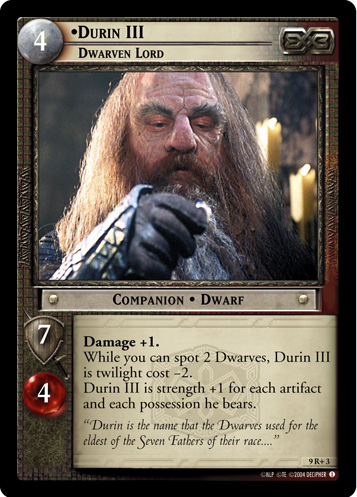 —feature in dwarf decks.
—feature in dwarf decks.Elven culture consists of elves, chiefly the elves of Rivendell and Lothlórien but also one far-ranging elf archer from Mirkwood. Many elves, especially in earlier sets, are allies, representing their tendency to not leave their home forests. The main characters of this faction are Legolas, Arwen, Elrond, and Galadriel.
Gandalf culture chiefly consists of Gandalf and his various schemes and accoutrements. It started off with Gandalf as the only companion in the faction, but over time it added his friends like Radagast, The Brown (9R+26)
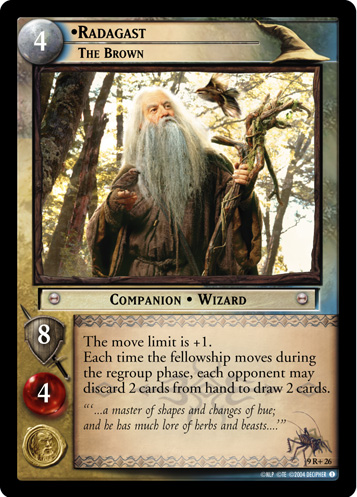 . It also became home to a number of subfactions or characters that don't fit into any other faction. The Ents of Fangorn, chiefly Treebeard, fit in here, as do the men of far-flung kingdoms (particularly Dale) that sent dignitaries to Elrond's council. It also includes oddballs like Ghan-bûri-Ghan, Chieftain of the Woses (0P56)
. It also became home to a number of subfactions or characters that don't fit into any other faction. The Ents of Fangorn, chiefly Treebeard, fit in here, as do the men of far-flung kingdoms (particularly Dale) that sent dignitaries to Elrond's council. It also includes oddballs like Ghan-bûri-Ghan, Chieftain of the Woses (0P56)
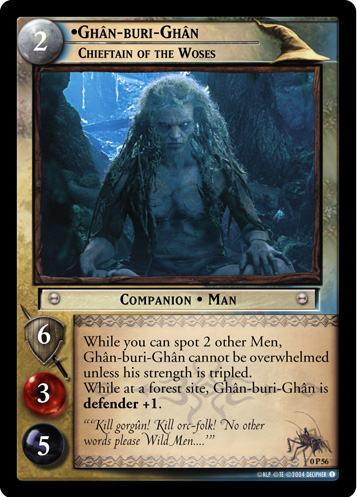 and Grimbeorn, Beorning Chieftain (14R6)
and Grimbeorn, Beorning Chieftain (14R6)
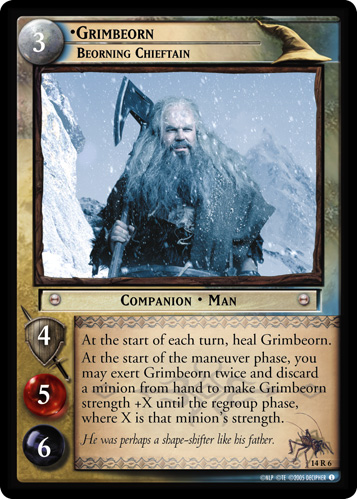 .
.Gondor culture consists of the men of Minas Tirith, their allies in Dol Amroth, and the rangers of the Dúnedain. It also includes their Númenorean ancestors, like Elendil, The Tall (9R+32)
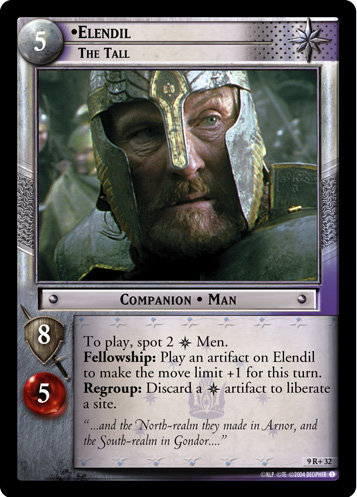 and Isildur, Bearer of Heirlooms (9R+33)
and Isildur, Bearer of Heirlooms (9R+33)
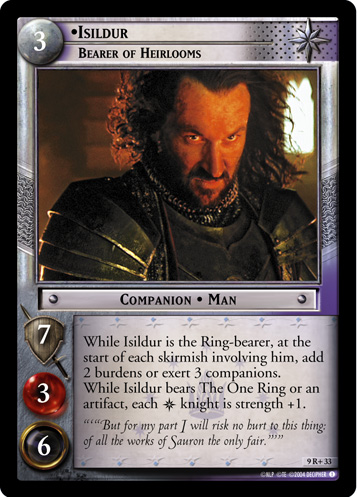 , and the wraiths bound by those ancestors, like King of the Dead, Oathbreaker (8R38)
, and the wraiths bound by those ancestors, like King of the Dead, Oathbreaker (8R38)
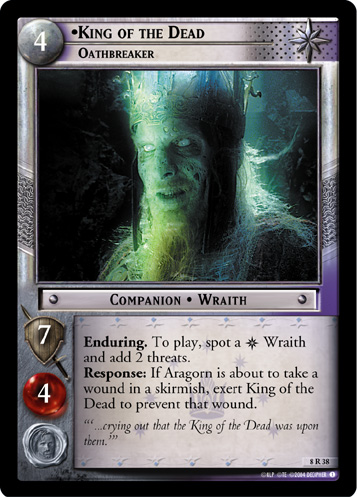 . The main characters of this faction are Aragorn, Boromir, and Faramir.
. The main characters of this faction are Aragorn, Boromir, and Faramir.Rohan culture consists of the men of Rohan, both the fighting horselords and -lady and the armies of the Riddermark, but also the villager civilians (appearing as allies and followers) they are protecting from Saruman's encroachment. The main characters of this faction are Eomer, Eowyn, and Theoden.
Shire culture consists of the hobbits of the Shire, and until Reflections there was at least one
Shire card in every single game. Hobbits tend to be homebodies rather than going on foolish adventures, so many of them are allies instead of companions in early sets, and many more characters only appear as allies or followers. The main characters of this faction are Frodo, Sam, Merry, Pippin, and Bilbo.
Pre-Shadows Shadow cultures[edit]
Shadow cultures came in three waves: the initial cultures in the first set, then two new cultures (plus Gollum, below) in Towers Block, then a fundamental reorganization in Shadows.
Fellowship Shadow cultures:
Isengard culture consists of the servants of Saruman, as he unsuccessfully plots to play both sides against each other. It initially consisted of the fighting Uruk-hai, but later includes Saruman himself, his orc workers and overseers at Isengard, his scouting force of warg-rider orcs, and the disloyal men of Rohan led by Grima.
Moria culture includes the teeming goblins that infest the former dwarven underground city of Khazad-dûm. As Boromir points out, they have the Cave Troll of Moria, Scourge of the Black Pit (1R165)
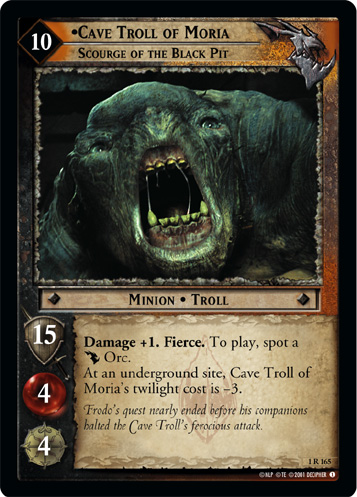 . It also includes the huge monsters that dwell there, such as the Balrog and the Watcher in the Water. This is one of the smaller cultures, since all of the characters in it appear in the Moria portion of Fellowship of the Ring.
. It also includes the huge monsters that dwell there, such as the Balrog and the Watcher in the Water. This is one of the smaller cultures, since all of the characters in it appear in the Moria portion of Fellowship of the Ring.Ringwraith culture is chiefly the nine unique Nazgul, led by The Witch-King as well as a suspicious man from Bree, Bill Ferny, Swarthy Sneering Fellow (2R75)
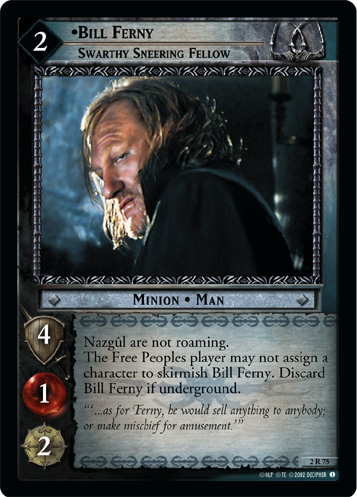 . Later it also includes the orc armies of Minas Morgul that invade Osgiliath and a handful of miscellaneous wraiths not directly affiliated with the Nazgûl themselves.
. Later it also includes the orc armies of Minas Morgul that invade Osgiliath and a handful of miscellaneous wraiths not directly affiliated with the Nazgûl themselves. Ringwraith culture would later be renamed
Wraith culture.
Sauron culture mainly consists of the orc and troll armies swarming out of Mordor to conquer Middle-Earth, led by Sauron himself. It's a large and varied faction overall. It's also a bit of a catchall, including some wraiths and The Mouth of Sauron, Lieutenant of Barad-dur (12R118)
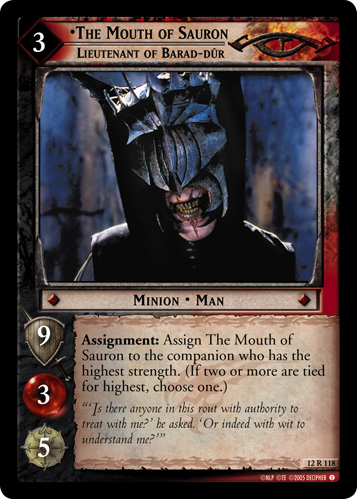 .
.
Towers Shadow cultures:
Dunland is another small culture. It consists of the Dunlending men, ill-equipped barbarian raiders and long-time enemies of Rohan. Except for Freca, Hungry Savage (9R+2)
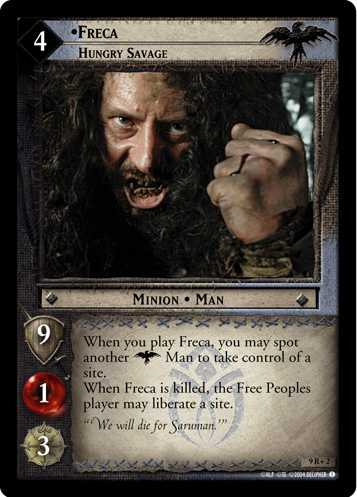 , all of the cards from this faction appear in Towers Block.
, all of the cards from this faction appear in Towers Block.Raider culture is another culture of men, this time the ones in service to Sauron. It's siloed into three separate subcultures. The first two were introduced in Towers Block: the heavily-armed and disciplined Easterlings and the oliphaunt-riding archer Southrons. Later, Siege of Gondor in King Block introduced the larcenous sea-going Corsair pirates, led by an infamous Peter Jackson cameo card: Castamir of Umbar (8R51)
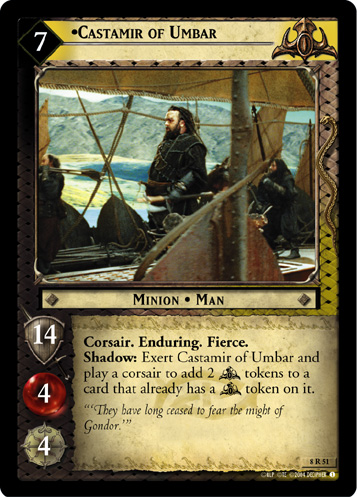 .
.
Gollum, playing both sides[edit]
The Gollum culture is unique in being the only cross-alignment culture, having both Free Peoples and Shadow cards. Free Peoples cards from this culture represent Sméagol as he serves Frodo and Sam as a simpering guide and scout, while the Shadow culture cards represent treacherous Gollum, as he schemes to betray them to Shelob and steal the One Ring for himself. Those three characters are the only ones in this culture. (While Sméagol and Gollum are the same person in The Lord of the Rings, they are considered separate characters for the purpose of this game, representing Gollum's tendency to act at cross-purposes with himself.)
This was the only culture to make its first appearance outside of a base set, due to timing with the release of the movie The Two Towers. As part of Decipher's licensing agreement, they were not permitted to reveal any "spoilers", and so Decipher needed to wait for the Battle of Helm's Deep expansion four months later to explore Gollum's split personality. It would be the last new culture of the Movie Block years.
Post-Shadows Shadow cultures[edit]
With the release of the eleventh set, Shadows, Decipher consolidated the various Shadow cultures, mostly retiring all of them except for Ringwraith (renamed
Wraith) and
Gollum cultures. This reorganization was largely along racial lines rather than factional ones. hese new cultures could draw, from their first appearance, upon images and material from all three films, and were structured to avoid the limited scope that plagued some of the niche older cultures that only appeared in a few scenes.
Men (often called "Evil Men" or "Skull Men") contains all of the men of
Dunland and
Raider cultures, the disloyal men of Rohan from
Isengard, and suspicious men from Bree (previously only appearing as one
Wraith card).
Orc culture contains all the orcs of
Moria and
Sauron's armies, as well as the orc workers at
Isengard and the Morgul Orcs from
Ringwraith.
Uruk-hai culture contains all of the uruk-hai of
Isengard's army, as well as the Cirith Ungol uruk-hai garrison from
Sauron culture.
Dunland and
Raider cultures were entirely retired.
Isengard,
Moria, and
Sauron cultures occasionally appeared in post-Shadows sets, but only on unique characters that didn't fit neatly into the new cultures, like Sauron, the Balrog, and Saruman. These cards mostly weren't decks unto themselves, but rather meant to be splashed into a deck that was primarily a different culture.
This cultural reorganization was controversial with established players. While the new cultures incorporated the characters and names from the previous cultures, cards from the old and new cultures were still considered separate. For example, if you already had a Sauron besieger deck, the new Beastly Olog-hai (11R108)
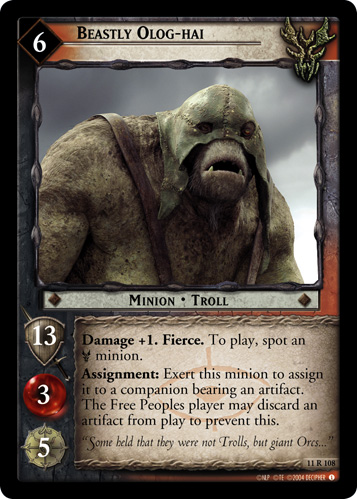 wouldn't work well in it, even though the Olog-Hai is part of the besieging armies of Sauron. If you wanted to use Beastly Olog-hai, you'd need to build a new deck, one using mostly new
wouldn't work well in it, even though the Olog-Hai is part of the besieging armies of Sauron. If you wanted to use Beastly Olog-hai, you'd need to build a new deck, one using mostly new Orc cards.
Wraith decks and
Gollum decks avoided this pitfall, but other Shadow cultures were sharply split into pre-Shadows and post-Shadows cards that largely did not work well with each other due to incompatible cultural enforcement.
Following the Shadows reorganization, no further cultures were added to the game.